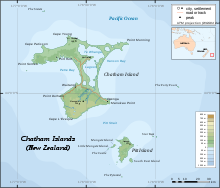Chatham plover
| Chatham plover | ||||||||
|---|---|---|---|---|---|---|---|---|

Chatham ringed plover (male) |
||||||||
| Systematics | ||||||||
|
||||||||
| Scientific name | ||||||||
| Thinornis novaeseelandiae | ||||||||
| ( Gmelin , 1789) |
The Chatham plover ( Thinornis novaeseelandiae ) is a rare species of bird in the plover family that is endemic to the Chatham Islands .
features
The Chatham plover reaches a size of 20 centimeters. In the adult male the forehead, face, neck, and throat ligament are black; in the adult female these areas are brown. The skull and face are separated by a white ring. The parting, the back of the head and the top are gray-brown. The underside is white. The beak is orange-red with a black tip. The legs are orange. The young birds have a white head and neck. The cap and eye patch are brown-gray. The brown beak has an orange base. The utterances usually consist of a " kleet ".
distribution and habitat
The Chatham plover breeds on Rangatira and Mangere Island in the Chatham Islands. Odd visitors have occasionally been found on Pitt Island . 21 individuals were discovered on the Western Reef in 1999, the last of which was taken into human care in 2003. A release program has been running on Mana Island near Wellington since 2007 and a release program on Motutapu Island in the Hauraki Gulf since 2012 . The nesting sites are in the mud flats, on salt marshes, as well as on sandy and scree beaches.
Way of life
The Chatham plover is monogamous. The pairs stubbornly defend their territory during the breeding season. He prefers to look for food on wet, bare or algae-covered rock slabs. The diet consists of copepods , amphipods and insect larvae. The breeding season lasts from September to April. The nest is built by both adult birds under dense vegetation, including Muehlenbeckia australis , tussock grasses and sedges . The clutch consists of two to three eggs. The incubation period is 28 days. Both parents take care of raising the young. The period in which the young fledge varies greatly. It ranges from 29 to 63 days.
Existence and endangerment
The Chatham ringed plover used to be widespread along the coasts of New Zealand's South Island . It died out here as early as the 1870s due to being stalked by feral domestic cats and brown rats . Between 1890 and 1910, the population in the Chatham Islands was seriously decimated by commercial collectors. In 1937 the number was estimated at 70 pairs. 85 birds were counted in 1968, 90 birds in 1970, 81 in 1973 and 100 specimens in 1974. Since the breeding season in 1998, the population has stabilized at between 156 and 166 specimens. In 1961 brood habitat was lost due to the elimination of the sheep on Rangatira, as forest had grown on the formerly grazed moor meadows. The greatest threat today is the spread of the New Zealand fur seal , fires, epidemics, heavy surf and storms as well as stalking by the New Zealand cuckoo owl , the great sku and the marsh harrier . BirdLife International classifies the species in the “endangered” category. In 2007 a couple was released on Mana Island , who raised one young in 2008 and five in 2009. Since the beginning of 2012 the population has been around 200 specimens, of which 17 specimens were brought to Motutapu Island in the Hauraki Gulf for a new breeding program in February 2012 . In late 2012, conservationists suffered a severe setback when 60 birds perished on Portland Island for reasons unknown.
Individual evidence
- ^ Department of Conservation: Critically endangered NZ shore plover released on Motutapu Island ( Memento of May 26, 2013 in the Internet Archive ) of February 20, 2012
- ↑ John. R. Platt: Tragedy in New Zealand: Dozens of Critically Endangered Birds Dead, Cause Unknown In: Scientific American of February 26, 2013
literature
- Walter Lawry Buller: A History of the Birds of New Zealand , 1888 Online
- New Zealand Shore Plover Recovery Plan 2001-2011 . Department of Conservation. PDF, online
- Josep del Hoyo et al .: Handbook of the Birds of the World. Volume 3: Hoatzin to Auks. Lynx Edicions, 1996, ISBN 84-87334-20-2 .
- Alison Davis: Breeding Biology of the New Zealand Shore Plover . In: Notornis (Supplement) 41: 195–208 (1994) ( PDF, online )
- Warren B. King on the behalf of the International council for bird preservation (ICBP) and the Survival service commission of IUCN (1978-1979): Red Data Book 2: Aves (2nd edition). IUCN, Morges, Switzerland. ISBN 0-87474-583-7
Web links
- Thinornis novaeseelandiae inthe IUCN Red List of Threatened Species 2011.2. Listed by: BirdLife International, 2008. Retrieved January 28, 2012.
- BirdLife International: Species Factsheet - Shore Plover ( Thinornis novaeseelandiae ) . Retrieved January 28, 2012.
- Videos, photos and sound recordings of Shore Plover (Charadrius novaeseelandiae) in the Internet Bird Collection
- Chatham ringed plover ( Thinornis novaeseelandiae ) at Avibase; Retrieved January 28, 2012.
- Thinornis novaeseelandiae in the Integrated Taxonomic Information System (ITIS). Retrieved January 28, 2012.
- xeno-canto: Sound recordings - Shore Dotterel ( Thinornis novaeseelandiae )
- Where are you bird

